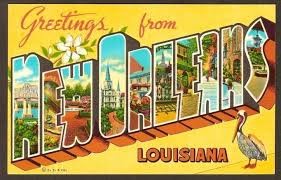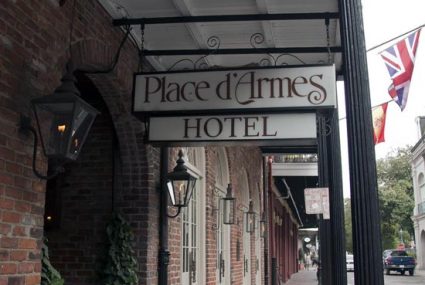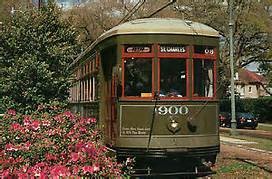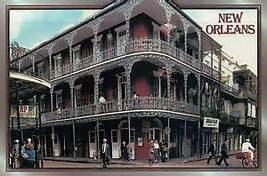2018 Manuscript Society Annual Meeting – New Orleans
April 18 – 21, 2018
 Introduction
Introduction
New Orleans – the Crescent City, the Paris of America, the Big Easy, that “land of dreamy dreams,” and the “city that care forgot” – has a long history and a rich culture that has made it a destination for colonists, immigrants, fortune-seekers, artists, musicians, and visitors of all backgrounds since its founding in 1718. Many may be familiar with our celebration of Carnival culminating in Mardi Gras (“Fat Tuesday”) and our cuisine, but may not be as knowledgeable regarding New Orleans’s wealth of archives and rare book holdings in our university, municipal, and private repositories. Showing their faith in the rebirth of New Orleans, the Manuscripts Society came to New Orleans in the Spring of 2006. The Manuscripts Society will once again be “’Way Down Yonder in New Orleans” for its Annual Conference in 2018, the 300th anniversary of the city’s founding.
[su_button url=”https://manuscript.org/projects/annual-meeting/schedule/” style=”flat” background=”#8B0000″ color=”#f7f7f7″ size=”6″ radius=”5″ icon=”icon: arrow-right” wide=”yes” icon_color=”#f7f7f7″]View 2018 Annual Meeting Tentative Schedule[/su_button]
JOIN US FOR A FABULOUS ANNUAL MEETING IN New Orleans!
April 18 – 21, 2018
As is always the case, the events and scheduling can change.
Registration for the Annual Meeting
Register on line or watch your mail for the registration packet! Registration for the Annual Meeting from April 18 – April 21, 2018 is $600.00 per person. Travel and hotel are not included.
Annual Meeting Registration Download
Hotel Reservations and Travel Information
Host Hotel
 The Place d’Armes Hotel sits in the heart of the New Orleans French Quarter and is just steps away from Jackson Square. Its beautifully restored 18th and 19th century buildings surround the lush tropical courtyards, beautiful magnolia trees, a sparkling swimming pool and fountains. It is a property of the Valentino Hotel Group, a New Orleans family that has welcomed visitors to New Orleans and the French Quarter for over 60 years. Rates: $169.00 (one bed) and $199.00 (two beds) based on double occupancy plus taxes.
The Place d’Armes Hotel sits in the heart of the New Orleans French Quarter and is just steps away from Jackson Square. Its beautifully restored 18th and 19th century buildings surround the lush tropical courtyards, beautiful magnolia trees, a sparkling swimming pool and fountains. It is a property of the Valentino Hotel Group, a New Orleans family that has welcomed visitors to New Orleans and the French Quarter for over 60 years. Rates: $169.00 (one bed) and $199.00 (two beds) based on double occupancy plus taxes.
Online reservations: www.placedarmes.com
Access code: SCRIPT18
Call for reservations: (800) 366-2743 and identify yourself as a member of The Manuscript Society.
Reservations must be made by February 17, 2018
Getting to New Orleans
There are a variety of options for traveling from the airport to the Central Business District including taxicabs ($36.00), airport shuttles ($24.00 one way, $44.00 roundtrip), and public transportation ($2.00 per person on the Airport Line (E2) managed by Jefferson Transit). See the http://www.shuttlefare.com/new_orleans_airport_shuttle_msy
JT Airport Line (E2): http://jeffersontransit.org/e2airport.php
 Restaurants and Local Attractions:
Restaurants and Local Attractions:
New Orleans is justifiably famous for its creole cuisine at historic venues such as Antoine’s, Brennan’s, Galatoire’s, Tujague’s, and Commander’s Palace. With the city’s ever-changing ethnic mélange, New Orleans also can boast of having eateries representing just about every nationality and style of cooking imaginable. http://www.neworleanscvb.com/restaurants/listings/
Other attractions:
- Steamboat Natchez – http://www.steamboatnatchez.com/
- Contemporary Arts Center – http://cacno.org/facility-rental
- Louisiana Philharmonic Orchestra – https://www.lpomusic.com/Online/default.asp
- Audubon Zoo – http://www.auduboninstitute.org/zoo
- Aquarium – http://www.auduboninstitute.org/aquarium
- New Orleans Museum of Art – https://noma.org/
- Hermann-Grima House – http://www.hgghh.org/
- Beauregard-Keyes House – http://www.bkhouse.org/
- Old Ursuline Convent – http://www.stlouiscathedral.org/convent-museum
- National World War II Museum – http://www.nationalww2museum.org/
- Confederate Memorial Hall – http://confederatemuseum.com/
- Ogden Museum of Southern Art – http://www.ogdenmuseum.org/
- Destrehan Plantation – http://destrehanplantation.org/

2018 Annual Meeting Schedule
Tentative Schedule
Wednesday, April 18, 2018:
Meeting of the Board of Trustees for the Annual Board Meeting.
The opening reception is at the exquisite 1826 Beauregard-Keys House. Named for two of its more famous residents, General P.G.T. Beauregard (who ordered the opening shots on Fort Sumter in 1861) and twentieth-century author Frances Parkinson Keyes, the residence is a particularly fine example of a raised center hall house. http://www.bkhouse.org/
Thursday, April 19, 2017:
Opening presentations
The Williams Research Center https://www.hnoc.org/research, a privately-funded museum, research facility, and publisher dedicated to the study and preservation of the history and culture of New Orleans, the lower Mississippi Valley, and the Gulf South region, will be the site of the opening plenary session. It is located just a quick walk from the Place d’Armes hotel. The opening session will feature Dr. Richard Campanella, a geographer with the Tulane University School of Orleans and the author of seven critically acclaimed books about New Orleans, including Bourbon Street: A History, Lincoln in New Orleans, Bienville’s Dilemma, and Geographies of New Orleans. The only two-time winner of the Louisiana Endowment for the Humanities Book of the Year Award, Campanella has also received the Williams Prize for Louisiana History, the Tulane Mortar Board Award for Excellence in Teaching, the Hannah Arendt Prize for Scholarship in the Public Interest, and the Monroe Fellowship from the Tulane’s New Orleans Center for the Gulf South. Mr. Campanella will speak on the diverse forces that have shaped New Orleans.
Following Dr. Campanella, Ms. Sally Reeves will present a talk, “Preservation the Notarial Records from 1735 -1970.” The New Orleans Notarial Archives (NONA) records date from 1735 to July 1970, during the time of Civil Law notarial practice when notaries archived their own records. The records are arranged the way they were created by notary and then by date.
Because New Orleans was once a French and a Spanish colony, records prior to the Louisiana Purchase (1803) are in French or Spanish. After the Louisiana Purchase, many 19th century records continued to be written in French. English eventually replaced French as the language of choice later in the century. However, it is not uncommon to find documents in other languages as well due to New Orleans being a major center for immigrants. A special feature of the New Orleans Notarial Archives is the plan books. Housed there is an important group of 5,149 large-scale 19th century, ink-and-watercolor lot surveys, about half of which also contain architectural drawings with floor plans, landscape designs, or other cultural details. The drawings date from 1803 to 1918, with 70 percent falling between 1830 and 1860. The lots were drawn to scale, signed, and dated by trained surveyors, civil engineers or architects. The illustrated buildings are painted and detailed in their scale, materials, and colors, while the grounds of the properties are rendered in heavy watercolors, predominantly hues of deep pink, bright blues, yellows, and greens.
The drawings were created as legal descriptions and advertisements of houses, lots and tracts of land offered for sale at public auction. The color yellow signifies the lot or lots being sold; pink indicates property not for sale. These artworks were designed to hang in auction houses and attract bidders to ensure that the properties sold for fair market value. Notaries received the plans a couple of weeks after the auction, at the time of the transaction, and officially signed or paraphed them to enter them into the legal record. The notaries then kept the plans in their études (offices) as part of their official archives. The plans, averaging 38 inches long by 24 inches wide, were too large to bind into the regular books of notarial acts, so notaries folded and bound them into oversize books of their own called plan books. http://www.orleanscivilclerk.com/research.htm
Ending the morning session, The Historic New Orleans Collection Staff will present a timely presentation on the cost of preservation and the care of manuscript materials.
Of course, New Orleans is known for food. As a result, a special visit is being planned to the Southern Food and Beverage Museum. It is representative of the city’s hunger to learn and preserve culinary knowledge and traditions. Lunch on Thursday will be at the Southern Food and Beverage Museum (SOFAB) and promises to be highly instructive. http://natfab.org/southern-food-and-beverage/
The Louisiana Research Center of the Old U.S. Mint houses a number of important manuscript collections from the 19th- and early-20th-century, including maps and plans, architectural drawings and family papers, but the oldest and most significant of its holdings –the one to which the state museum owes its existence in the first place- is its archive of French and Spanish colonial records, popularly known as the French Superior Council and Spanish Judicial Records (1714-1803). Ceded to the Louisiana Historical Society (est. 1835) by the legislature in 1859, the priceless documents have been on renewable loan to LSM since its creation in 1908. These records –notarial acts, successions and both civil and criminal court minutes- are in fact the other half of the French and Spanish colonial archive found at NONA, created by the very same notaries and clerks of court: NONA houses 90% of the Spanish notarial acts, the Mint 90% of the French ones; the Mint houses about 90% of the Spanish judicial records, the part remaining at NONA comprising successions almost entirely, rather than court minutes.
From 2013 until 2017 LSM was the recipient of an NEH grant to digitize the entire, massive archive and make it available to the public on its website. Extremely fragile and always difficult for the public to access, researchers can now view online the more than 18,000 colonial records documenting the commercial, cultural and legal practices of New Orleans’s earliest European and African inhabitants. https://www.crt.state.la.us/louisiana-state-museum/collections/historical-center/index
Returning to the hotel by 5:00 PM, the evening is yours to select from the dozens of excellent restaurants and enjoy the city.
Friday, April 20, 2017:
Tulane University Repository visits
Friday takes the society to the campus of Tulane University. Over the decades, the university has founded a number of excellent archives and institutes.
Southeastern Architectural Archive, a unit within Tulane University Library’s Special Collections Division, was founded in 1979 of collections from Prints and Drawings of the Manuscripts Department (now the Louisiana Research Collection) at Tulane University. Growing from a small number of groups of records from a few New Orleans architects and firms, SEAA now preserves over 135 collections from the New Orleans metropolitan region, Louisiana, and other parts of the gulf south. Over the last three decades, SEAA has become one of the largest architectural archives in the southern United States, housing nearly 1 million drawings, 25 thousand photographs, and many other records. https://seaa.tulane.edu
William Ransom Hogan Jazz Archive is the leading research center for the study of New Orleans jazz and related musical genres, including New Orleans ragtime, gospel, blues, rhythm and blues, and Creole songs. Among its holdings are 2,000 reels of oral history interviews with musicians, family members, and observers that document the stories surrounding the emergence of jazz in New Orleans from the late 19th century forward. Other holdings include sound recordings, film, photography, sheet music, personal papers, records of the American Federation of Musicians local 174-496, ephemera, and realia. http://jazz.tulane.edu/
Lunch will be across St. Charles Street at the Audubon Park Club House. http://audubonnatureinstitute.org/clubhouse-cafe
The strength of the Amistad Research Center‘s holdings—the manuscript collections—contain over 15 million documents and 250,000 photographs that record those who charted African American history and race relations in the United States. Collections center on education from the Postbellum period to the present; religious and Masonic orders, materials chronicling the Civil Rights Movement and other social justice movements; United States organizational involvement in Africa; the cultural arts, with a particular focus on the arts; personal papers of African American political and community leaders in New Orleans; and medical history, particularly in the Jim Crow south. Amistad Research Center http://www.amistadresearchcenter.org/
Middle American Research Institute. Most people think of the port of New Orleans in terms of the expression “The Gateway to the Americas.” However, New Orleans has long been a center of publishing, education and research involving the Americas. One such example, is the Middle American Research Institute. Founded in 1924, the Middle American Research Institute (MARI) at Tulane University has been supporting research in Middle America for over 85 years. The Institute also stewards an extensive collection of textiles and artifacts from not only Mexico and Central America, but also the US Southwest and South America. It also houses a large archive of letters, field notes, maps, and photographs from the scores of field projects it has sponsored. Furthermore, the Institute continues to support a variety of anthropological, archaeological, ethno-historical, linguistic, and ethnographic research projects throughout Mexico and Central America. http://www.tulane.edu/~mari/visit.html
Returning to the hotel by 5:00 PM you have a free evening.
Saturday, April 21, 2017:
On Saturday morning, we return to The Historic New Orleans Collection for a closing session dedicated to New Orleans collectors.
Dr. Florence Jumonville, curator at the Touro Infirmary Archives, will present, “Edgar Alexander Parsons: Louisiana Collector; For almost 40 years Mr. Ed Poole, with his wife Susan, has been documenting, recording and preserving film memorabilia (i.e., press books, movie stills, movie posters, general press materials, etc.). Beginning as collectors, they have been both retail and wholesale dealers and are now full time researchers devoting their energies to movie memorabilia. Their accomplishments include publishing the first reference book on movie posters. Rounding out the morning will be a curator’s tour of the exhibition, “Founding Era.” Dedicated to the early years of New Orleans, it will feature documents from French, Spanish and US archives, as well as paintings from Versailles.
Lunch and the afternoon are on your own.
The closing banquet will be at Arnaud’s Restaurant. https://www.arnaudsrestaurant.com/ Located in the heart of the French Quarter, Arnaud’s offers classic Creole Cuisine and exemplary service in beautifully restored turn of the century dining rooms. Since its inception in 1918, Arnaud’s has remained true to its traditions and courtesies. The dinner presentation will focus on New Orleans jazz. The presentation will be in the capable hands of jazz clarinetist Dr. Michael White. Dr. White has been instrumental in keeping alive the New Orleans jazz tradition of his ancestors, some of whom were among the earliest jazz musicians. A professor of Spanish and African American Music at Xavier University in New Orleans, White has become well known on the jazz scene. He performs, writes and lectures on jazz, and is among a very few current clarinetists to develop an original authentic interpretation of the exciting New Orleans style. He has been widely acknowledged as an expert in the field of traditional New Orleans jazz
In addition to touring worldwide with his own Original Liberty Jazz Band and other groups at major concert halls (such as Carnegie Hall and Lincoln Center) and festivals, he has appeared in numerous documentaries, films and interviews. White has performed and/or recorded with noted musicians such as Wynton Marsalis, Lionel Hampton and Marcus Roberts. He has played on twenty recordings, including his own critically acclaimed Crescent City Serenade and New Years at the Village Vanguard.
Enjoying a dual career as a performer and educator, Dr. White is on the faculty of Xavier University in New Orleans and the Juilliard School in New York.
